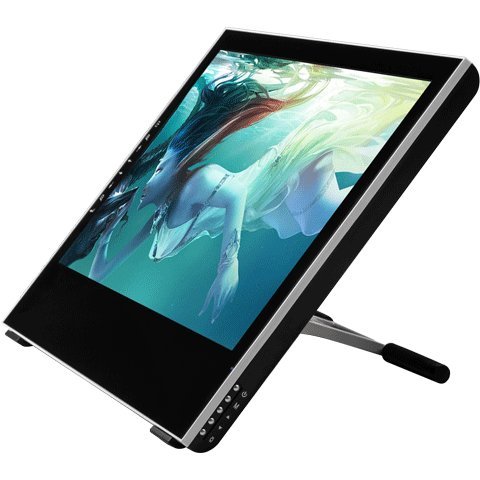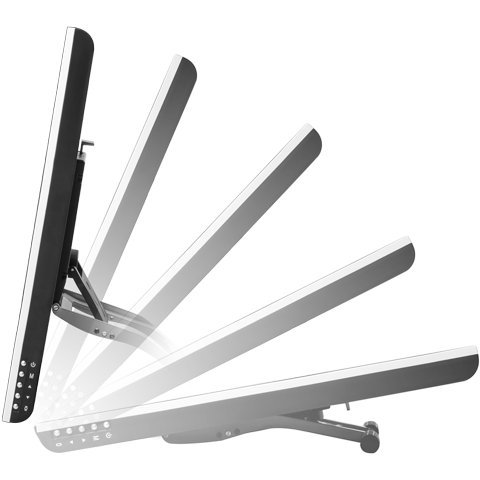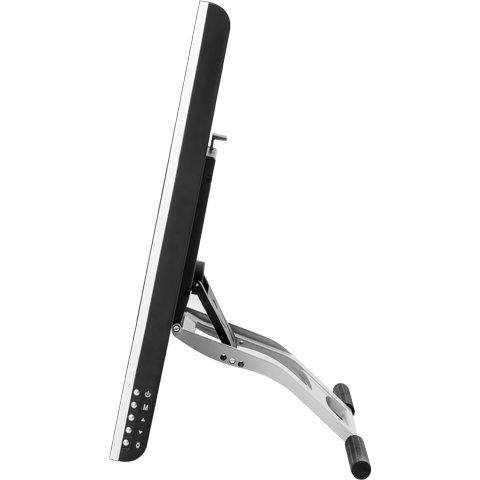We have tattoo artist Craig Sheets who's reviewing his Yiynova MVP22U V3 pen display tablet for us - Parka

I am a tattoo artist by trade and had been using a Wacom 12WX for a while and decided it was time to upgrade to a larger digitizer.
My drawing style lends itself to drawing large. Having a Wacom tablet previously made me inclined to search for a larger Wacom tablet. I bought the Wacom Cintiq 22HD first.
I also wanted another digitizer for work, but the price of 2 Wacom 22HD’s seemed excessive. I had been hearing about some of the UC Logic digitizers and decided to give Yiynova a shot after reading several reviews on Amazon of the Yiynova MVP22U V2 (yes you read that right). I received my MVP22U V2 and noticed a jitter issue with my tablet. The jitter issue was not bearable so I contacted the seller and they went through some troubleshooting with me. After exhausting all other possible problems, it was determined that I should send back my tablet for a new one. The seller was helpful and even offered an upgrade to the newer Version 3!
Setup
Set up was a snap. I will say I'm used to UC logic installs. A word of advice. If you used any Wacom products on your computer, make sure ALL drivers for Wacom are uninstalled before installing your UC Logic drivers. If you need help here is a link to help completely remove them, visit http://forum.wacom.eu/viewtopic.php?t=7926
Before installing the hardware of your tablet, you must install the drivers. The drivers are available on Yiynova’s website. Installing the software is pretty straight forward.

Key specifications
The Yiynovas screen is a 1920x1080 resolution 21.5 inch IPS panel display with an LED backlight. The screen measures 10.55 inches in height by 18.77 inches in width. The display connection is DVI-I. The digitizer boast 2048 levels of pressure sensitivity with 4000 line per inch resolution.
Unboxing

The packaging is nice, everything was tightly secured and came well protected. There were no dings or scratches. Everything came in working order.

The box design is pretty bland, but that's not what we are paying for anyway. I actually think this is a smart idea. Packaging to me is for protection, and since most of the advertising is done online for this company. Why not save us a few dollars?

Inside the box:
- Yiynova MVP22U V3 Digitizer Tablet Monitor
- Power adapter
- P2H Stylus box with 2 extra nibs and nib remover
- P2X Stylus with 2 extra nibs and nib remover
- Stylus holder
- 3 display adapters DVI-I to displayport, VGA and HDMI
- Right and Left Artist gloves with yiynova logo
- Instruction manual and install Disk, and warranty and quick start leaflet.

The P2X (vertical) and P2H (horizontal) in the supplied stylus cradle.
Both feel solid and have a bit of weight to them. Not too much weight, but enough to feel solid. Both have no eraser. This is something I think is inherent in the technology used by UC Logic digitizers, because none of them have it.
Each stylus unscrews to reveal a battery compartment. They both require AAA batteries. My experience has been the batteries last quite a while. I personally enjoy the weight of the stylus in my hand.

The plastic case opens to reveal a compartment for a nib remover and extra nibs. The P2H is on top, and the P2X is on the bottom. I like the identifier ring at the bottom of the P2X. It reminds me of my Wacom stylus.
A look at the digitizer tablet

The chassis still says VGA I’m guessing as a leftover from the earlier incarnation, but it has been upgraded to DVI-I.
The cable is hard wired, something I am not fond of. There is a DC 12v insert for the power supply directly underneath. The rubber feet can be seen underneath, they offer great protection from bumping against the table as you set it down. They also help to prevent the digitizer tablet from pushing forward as you draw or rest your hand on the surface.

Display controls located on the bottom right corner include: Power, Menu, Up, Down and Enter.
I found the placement of them fine, but I wish there are labels for them on the front or side to aid in seeing which button I am pressing from the front viewing angle. I also found, when this tablet is on my monitor arm (Ergotron LX), I sometimes hit these buttons when placing the tablet down on the desk. A minor inconvenience, but I felt I should mention it.

The stand feels rigid and sturdy. The rubber feet help hold the tablet firmly in place wherever it rests.

The shortcut keys at the top of the screen feel well made. It takes a bit of force to actuate, so no accidental presses here. They give a nice audible click when pressed to let you know you have fully actuated. I also don’t see light leaking through the edges as has been mentioned in some reviews of earlier versions. Also, note the “lip” at the top, this with those tabs seen to the right and left of the shortcut keys, hold the glass surface in place. I wish the front face was a little more sleek, I didn’t find these to be an issue, just, cosmetically, I don’t find this to be attractive.
Overall I find the presentation to be adequate, I see a few area for improvement cosmetically. I find none of these to be deal breakers. The glass surface to me is very reflective, I prefer the matte finish of my Wacom 22HD to this surface. That is just for me. I know others like the slick surface, because colors seem more vibrant. This is absolutely true, colors are definitely more vibrant through a clear surface. The colors on this monitor are exceptional. I would say even better than my 22HD. The colors are very rich and precise. Right out of the box it was calibrated perfectly. There was almost no noticeable difference after I re-calibrated with my Spyder Pro. Which leads to…
Calibration and Color Spectrum

Place Spyder here! I so love this thing!

The color gamut is normal. I have seen a couple people mention that it was wide, it’s not. The colors are very crisp, the blacks are very black. The whites white and everything in between is beautiful! 96% sRGB

74% Adobe RGB
Yiynova MVP22U V3 vs Wacom Cintiq 22HD

A size comparison of the Yiynova MVP22U V3 to the Wacom 22HD. The Yiynova is considerably smaller and significantly lighter as well.
You can easily see the difference in reflectiveness of the drawing surfaces. I do like the drawing surface of the 22HD best. I also like that it has side mounted shortcut buttons, as well as a zoom strip on the back. I have seen some screen covers advertised online that might be cut to fit the Yiynova. I will be trying this in the future.

You can see the different approaches to the stand mechanism in the back as well. I like how light the MVP22U V3 is. I also like that it is firmly attached. One time I was holding my Wacom and the stand actually slipped off the tablet and split my toenail. That stand is extremely heavy! The Wacom stand has the ability to swivel the face of the tablet to allow better angles when drawing. This is nice, but not something that Control+R in most programs couldn’t handle.
Inside the center ring are 4 screws that reveal a compartment for switching out cables of the Wacom 22HD. This came in handy when my new puppy chewed through the DVI-I cable. I was happy I didn’t have to ship it back for a minor repair like that. Yiynova could take a cue from this. The top silver tab on the Yiynova releases the arm at the bottom to allow you to tilt the display back, or pull upright. The Wacom has the two side bars for this purpose.
Pressure sensitivity of the stylus

Overall the P2H requires more force to actuate all levels of pressure. The P2X seems softer. The best way I can describe the feel of the pressure curve is the P2H feels like a colored pencil in pressure sensitivity and the P2X feels like a brush.
Earlier renditions of this tablet allowed me to adjust the pressure curve. For some reason, in this newest incarnation V3, that feature has been removed. I am assuming that is why they now give me two styli. I find the two styli to be a perfect amalgam of the two predominant pressure curve camps. I personally prefer the pressure curve of the P2H.

This sketch was done with the MVP22U V3. This is a drawing for one of my clients. It is a half sleeve, shoulder blade and chest. Line work also done with the Yiynova in the image below.

The tablet tracks very well. I was able to get clean consistent lines throughout. I felt like the tablet tracked my hand no matter how slow or fast I drew. The earlier version 2 seemed to me to have trouble tracking at extremely slow speeds. I am led to believe this is an isolated incident. Version 3 tracks perfectly, so I think that rings true. In my field I need clean consistent lines, and as you can see that is exactly what I got.
Video review
Conclusion
Pros:
- This tablet does everything with just as much precision as my Cintiq 22HD. Slow lines now track perfectly. I did a ruler test even at slow speeds, the lines were perfect. I used a circle template to trace perfect circles, no jitter whatsoever. There is enough pressure curve to get use of all levels in the sensitivity. This tablet is at my place of work because it is smaller and requires less desk space, I took the Cintiq home.
- The size of this tablet monitor is much more compact which I love. It is also lighter which allows it to be attached to my Ergotron arm with no sag. I haven’t tried attaching my Wacom to the ergotron, but it is considerably heavier. I think it would sag.
- The colors on this monitor are even better than my Cintiq. Very rich and precise. I used a Spyder pro to calibrate, and it was spot on out of the box. My monitor had no light bleed.
- The stand is sturdy and feels solid
- The cables have been upgraded to DVI on this version so no more VGA (yay!) and I can connect it to my card now without adapters.
- It comes with 2 pens which have a slightly different pressure curve. both feel nice and sturdy. They require a battery, but the battery lasts a very long time. i didn't feel like that was an issue. In fact I kind of like the weight.
- The buttons at the top feel sturdier than my V2, the first one had a little play in it these are solid and feel well made. In fact the whole body of this device feels really well made.
- It worked with all of the software I use. Photoshop, Manga Studio mostly.
- The people at Panda City, the seller, did a great job helping me when I had a problem with the last tablet. They were attentive and helpful. So on the chance you get one that is defective you can contact them. They will definitely take care of you.
- The best thing of all is that for half the price I got a tablet that performs as well as my Cintiq. I wish I had gotten this before buying my Cintiq, I would have just bought another one.
Cons:
- I prefer a textured surface, I will get a textured screen protector anyway, so not a big deal.
- I wish the buttons were on the side, it would help with the work flow. Also a zoom strip or wheel would be a nice addition.
- I wish it had a full screen mapping at the push of a button, but this is UC Logics' fault not Yiynova. UC Logic, get with the program on this! Hopefully future driver updates will remedy this.
- Cosmetically I feel the face of this device could be a little more uniform, I am not a fan of the protruding lip on the sides.
- I also wish this tablet had ports to plug the cables in instead of hardwired cables. This is a big deal to me. This is something Yiynova could easily design into another version of this product, and I think they should. No one wants to have to send back their daily driver because it got a short in one of their cables.
At any rate none of these things are worth another $800, which all in all makes this a great tablet. Especially for those not willing to shell out the extra money for something like the Wacom 22HD. I was extremely disappointed after getting my Version 2. I can almost say I went into this expecting more disappointment, but they turned this franchise around for me. I would, and have recommended this to my colleagues who have also had no regrets. It’s definitely been a worthwhile investment for me. On a scale from 1 to 10 I would rate this product an 8.5. Mostly because of the cables being hardwired.
Availability
Check out more reviews on Amazon. Below are direct links to the Yiynova MVP22U V3 product pages:
Amazon.com | Amazon.ca | Amazon.co.uk | Amazon.de

































































































Add new comment